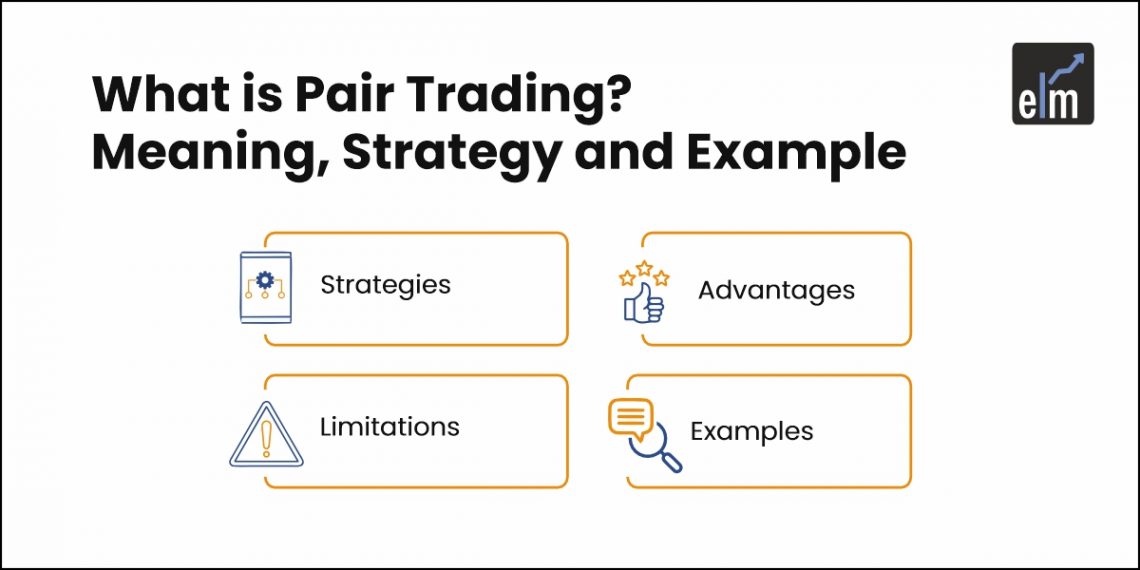In the game of trading, strategies are designed to maximize profits without increasing the risks. However, a unique approach comes with ‘Pair Trading’, which focuses on relative price movements between two correlated assets. For both the aggressive trader and the beginner curious, knowing all about the pair trading strategy and its focus on relative price movements unveils opportunities for profit from either market condition. This blog will explore the meaning, strategy, advantages, limitations, and pair trading examples to help you grasp this powerful concept.
What is Pair Trading?
Pair trading involves simultaneously buying one asset while short-selling another correlated asset to capitalize on statistical arbitrage opportunities. It creates an opportunity for profits from the price divergences between the two. Arbitrage potential arises from price divergence between two assets with a strong historical price correlation.
Unlike directional trading, which relies on market-wide trends, pair trading is centered on relative price differences between two assets. The principle of core value is that the paired assets share a historical relationship likely to persist. Whenever one asset outperforms or underperforms the other, traders capitalize on the temporary divergence.
This strategy is very common for hedge funds, institutional investors, and experienced traders in generating profit across different market conditions. The focus on relative price movements makes it a pretty effective technique for reducing the risks caused by broader market fluctuations.
Pair Trading Strategy
The statistical-based pair trading strategy relies on identifying correlated assets through techniques like cointegration analysis and statistical backtesting. Traders typically look for price divergence between these two assets, expecting them to eventually return and track along again.
The following are usually the steps taken in a pair trading strategy, from asset pair selection to the execution of long and short trades:
- Selection of Pairs: The preliminary stage includes the selection of two correlated assets. doing so, correlation and cointegration tests may be conducted to analyse the strength between two securities. Pairs of stocks representing similar industries or sub-industries, such as those in the tech industry and energy, are also generally preferred.
- Monitoring Divergence: Traders track the price relationship between the assets after selecting the pair. When the price gap has exceeded a historical norm, that is the time to make an opportunity. The strategy works best with liquid assets to minimize liquidity challenges and slippage in trading during execution
- Execution of Trade: Once divergence is observed, traders will go long on the underperformed asset and short on the outperformed asset. The idea is that the underperforming asset will rise while the outperformed asset will stabilize or start falling.
- Exit Strategy: The trade is closed when the relationship between the price of two securities returns to normal or when the spread of two assets converges. There are profits from moving prices of two assets, and the trader could close a position once the spread narrows.
Advantages of Pair Trading
Pair trading offers several advantages, making it a popular strategy for traders seeking relative price opportunities.
Reduce Risk
A key benefit of pair trading is its risk mitigation due to its market-neutral nature, making it ideal for achieving risk-adjusted returns. Unlike directional strategies, whose profits are generated from broad market movements, the relationship between two assets generates all the earnings in pair trading strategies. This balance comes directly from its structure, meaning holding both long and short positions, thus mitigating the impact of market volatility.
For example, if one of the assets is losing money, the other might balance it out, keeping the portfolio steady. This means that this kind of trading is particularly suitable for those who require risk-adjusted returns. It is most preferred by traders who seek to limit losses from volatility.
Market Neutral Trading Opportunity
One thing that makes pair trading remarkable is that it can earn profits in any market condition, whether bullish, bearish, or neutral. It thrives in volatile market trading, allowing traders to profit from convergence rather than market direction.
This characteristic makes pair trading especially valuable in periods of high market volatility. For example, a bullish trend in one may balance out a bearish trend in the other; hence, there will always be profit opportunities regardless of the market’s overall trajectory. Traders may thrive irrespective of the market environment under such resilience and, therefore, can prefer pair trading during uncertain times.
Limitations of Pair Trading
Although pair trading has several merits, it has limitations that a trader considers before following the strategy mentioned above in the discussion.
Research & Analysis
- Statistical Analysis Needed: Pair trading requires a lot of statistical analysis to identify correlated asset pairs and track price movements. The trader has to monitor market trends and use sophisticated tools to spot price discrepancies between the assets.
- Long Research Time: Traders must research the deepest in historical data continuously monitor market conditions, and sometimes use complicated algorithms to catch profitable opportunities. This makes pair trading more research-intensive compared to other strategies.
- Risk of Loss Without Research: The trades could suffer huge losses if the price correlation between the two assets breaks down. Lack of experience or incorrect analysis will make the strategy ineffective and may cause losses.
Low Liquidity
- Dependence on Liquid Assets: Pair trading relies on high-liquidity stocks that can be traded smoothly for long and short positions. The best strategy works when the assets are traded with zero significant delays.
- Execution Challenges: The problems associated with illiquid stocks include wider bid-ask spreads, increased slippage, and delayed trade execution. These can further decrease profitability and cause issues when entering or exiting positions.
- Missed Opportunities: Low trading volumes will make execution delayed, which can mean that the traders may lose profitable opportunities. Assets to be involved in pair trading must have high liquidity so that the execution of a pair trading strategy will be successful.
Example of Pair Trading
Let us say two stocks in the technology sector, Stock A and Stock B, are used in an example of pair trading.
Step 1: Pair Selection
Stock A and Stock B, based on historical price data analysis, have shown strong trends, making them ideal for sector-based pair trading. Each of them is a leader in technology, so they would be great pair-trade candidates.
Step 2: Divergence
In the last few weeks, Stock A has dramatically outperformed Stock B in terms of price; therefore, the market price has been surpassed by this divergence in price. A trader sees such a topic as an opportunity for a pair trade. In its past relationships, this kind of pair of stocks shows that it should be expected to move in a parallel manner; thus, the stock will be anticipated to ‘catch up.’
Step 3: Execution
The trader takes a long position in Stock B, which is the underperforming asset, and a short position in Stock A, which is the outperforming asset, and hopes that the price spread between the two will narrow.
Step 4: Convergence and Exit
Over the following weeks, the price of Stock B has started to recover well, whereas the price of Stock A has stabilized. So, the trader closes both positions, taking profits on the price convergence in which the price of stock B has increased and that of stock A has flattened. This example illustrates how to pair trading profits from relative price movements rather than the market’s direction.
Conclusion
Pair trading is a trading strategy designed for market volatility risk reduction by exploiting dynamic market conditions and relative price movements between assets. Taking long and short positions in correlated stocks would result in lower market risk and profits under both bullish and bearish market conditions. It works very well in an efficient way for the volatile market when directional trading strategies might not work.
Further benefits are the risk mitigation and potentiality of profits independent of the market, but close attention and good market data and statistical analysis are necessary. Challenges such as low liquidity constraints and execution delays require careful planning and continuous research for successful pair trading.
For sure, pair trading proves useful for the professional trader who seeks to exploit the innate price relationship between two assets. But also, great emphasis should be vested in the weaknesses of this strategy, and risk management should be in a plan to make the most out of it. There can be an effective expression of pair trading by consistent returns, even under varying market conditions, if well-researched and appropriately executed.
Also Read: All 35 Candlestick Chart Patterns in the Stock Market-Explained
You can visit StockEdge to explore detailed market insights.






